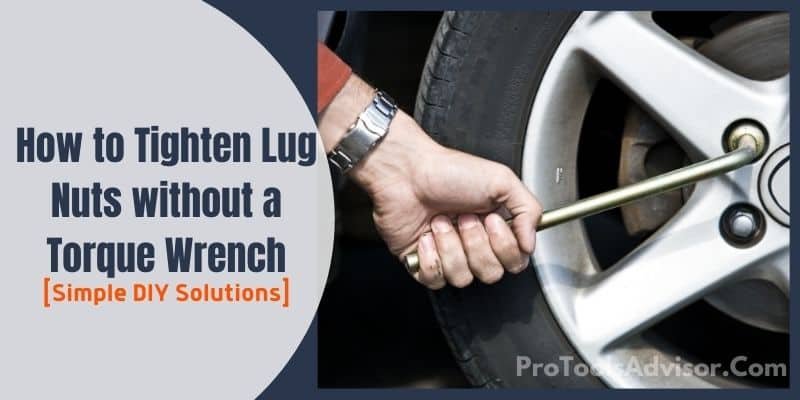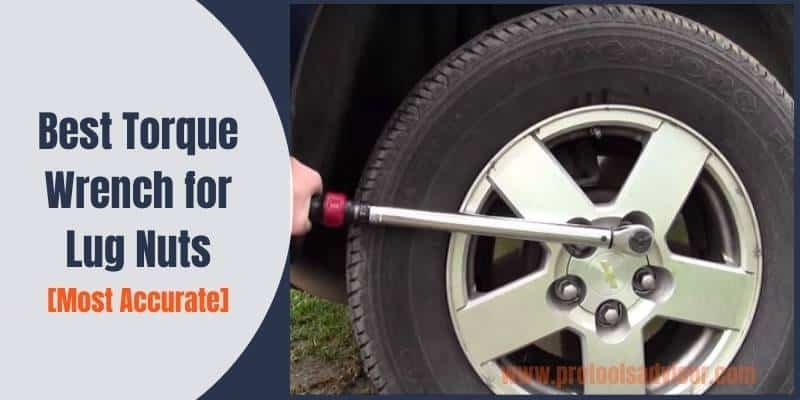Disclosure: This post contains affiliate links and I will be compensated if you make a purchase after clicking through my links. Learn More
You might be in a situation at any time where you’ll be required to change the tire and screw (or unscrew) lug bolts for that, and you’ll have to deal with it without the luxury of having a torque wrench in the trunk.
Well, this is not a big issue as long as you have several other tools (which you most definitely should as a car owner) available to help you in the crisis. Let’s face it! We are here to teach you how to tighten lug nuts without a torque wrench.

What’s the Main Goal in Lug Nuts Tightening?
The main goal is to apply adequate torque for tightening the nut. A torque wrench is built for that. If you are using some other tool, you have to provide the necessary torque on your own.
You might be wondering, how to guess torque without torque wrench?
To achieve the desired torque, you have to put enough weight onto the lug nut which could be half of your body weight depending on the distance between the tightening socket and your hand on the other axis.
Briefly put, lean as hard as you can to put enough force to screw the lug onto its place. The same level of torque is required for unscrewing the bolts as well.
This brings us to our main concern, how to tighten lug nuts without a torque wrench? Let’s see some of the methods you can try.
Tightening Lug Nuts Without a Torque Wrench: DIY Solutions
1. Breaker Bar Method
The best thing about the breaker bar is that it includes a drive to grip onto the lug. Choose a bar that can extend so that you can expand it for removing nuts, and then shorten it to help screw them back. The torque is higher when the bar is held from a more distant axis.
Removing and Tightening Process:
Step 1: Remove the Lug Nuts
Expand the bar. It should be more than 30 cm or 12 inches long for the desired torque.
Place the socket drive onto the nuts and secure it for rotation.
Hold the bar by the axis on the other end. Make sure there’s a distance of at least 30 cm (12 inches) between your hand and the drive.
Rotate the bar counterclockwise by forcing half the mass of your body weight and remove the lug nut.
Repeat the process for all nuts.
Step 2: Jack up the Car
Jack up the vehicle to tighten the same nuts onto the spare wheel.
Step 3: Tighten the Lug Nuts
Shorten the breaker bar for lowering the torque, as extra leverage might lead to thread stripping.
Screw the nuts onto their place. Use hands initially instead of a tool.
To secure permanently, hold the bar by the axis while the socket drive is placed right over the lugs. Rotate the bar clockwise while pushing with your body mass. Don’t go overboard with the push.
Repeat the process for all bolts.
2. Tire Iron Method
A lot of people prefer tire iron over breaker bars, although many find it more of a hassle to use the former. It’s a very easy, quick and most popular method.
Four-way crossbar ones are the primary go-to tire iron in this sort of situation, but other models work just as fine, as long as you’ve found the right socket for the nut. You might need to put your full body mass to unscrew the bolt.
Removing and Tightening Process:
Step 1: Remove the Lug Nuts
Place the right socket onto the targeted bolt for accurate grip. Start rotating the tire iron counterclockwise to loosen the bolt.
Get on the counterclockwise side to put more force and body weight onto loosening the nut.
Repeat the process for all lugs.
Step 2: Jack Up the Car
After successfully unscrewing bolts, remove the faulty tire, and jack the car up to attach the spare wheel.
Step 3: Secure the Lug Nuts
Bring in the spare. Try to secure the nuts onto the tire using your hand. Screw them in as far as you can.
Step 4: Bring the Car Down
Lower the jacked side to do the rest of the tightening.
Step 5: Tighten the Lug Nuts
Again, fit the socket onto the almost-secured nuts and rotate clockwise to tighten them. If necessary, stand on the side of rotation to put extra pressure.
Repeat the process for each lug. Don’t put too much pressure beyond the needed torque.
3. Lug Wrench Method
Not the first solution people would go for, mostly because it’s not built for applying torque required for lug nuts adjustment. But it works wonders if done right. You can use a T wrench too, as they work the same way.
Removing and Tightening Process:
The process is pretty similar to that of a breaker bar or tire iron, you only have to put more force and weight to provide the torque.
Measure your body mass (weight) and distance between your hands and lugs. Count the torque in newton and figure out how much pressure you should put onto the socket to get it to loosen or tighten the nuts.
FAQs:
Is it possible to overtighten lug nuts by hand?
It’s least likely to happen with a torque wrench or tire iron; these tools are built to rotate without going beyond a safe distance. If you’re rotating at a compliant pace, they’ll do the job with no thread harmed.
However, not the same case with a lug wrench or bar breaker. Pushing with too much body weight while using these bad boys can always result in overtightening.
And just by hands in the absence of tools? Not really, unless you’re an android with superhuman strength or forcing it all wrong by going too hard on the nuts.
Can Overtightening Lug nuts Cause Vibration?
Yes, it absolutely can. Overtightening nuts may distort the brake rotor or damage the threads by stripping them off completely, which causes instability and vibration.
Without proper measures, the tire might start losing air, or lugs can get stuck on the wheels as the warping (vibration) can turmoil the hub as well.
In What Order Should You Tighten Lug Nuts?
To avoid earlier lugs getting loose or possible shifting, don’t go clockwise or counterclockwise while screwing. There are some specific patterns to follow depending on the number of nuts that need to be screwed.
Let’s demonstrate the numbers clockwise for a clear understanding.
- In the case of four nuts, go 1-4-2-3
- 1-3-5-2-4 when working with five nuts
- Follow the 2-5-3-1-6-4 pattern for tightening six lugs
Final Words
Although it’s a nice addition to the toolbox and saves you some manual calculations during tire changes, a torque wrench isn’t an “absolute necessity” to apply torque. As long as you have a working tire iron, extendable breaker bar, or just a lug wrench in the back of your car, you’re sorted for the drill. With the help of these tools and correct measurements, tightening lug nuts without a torque wrench isn’t that complicated.


